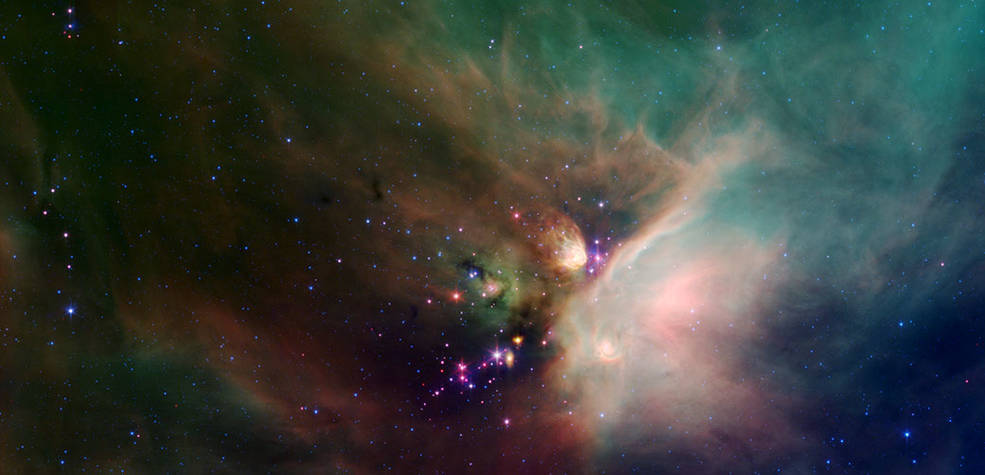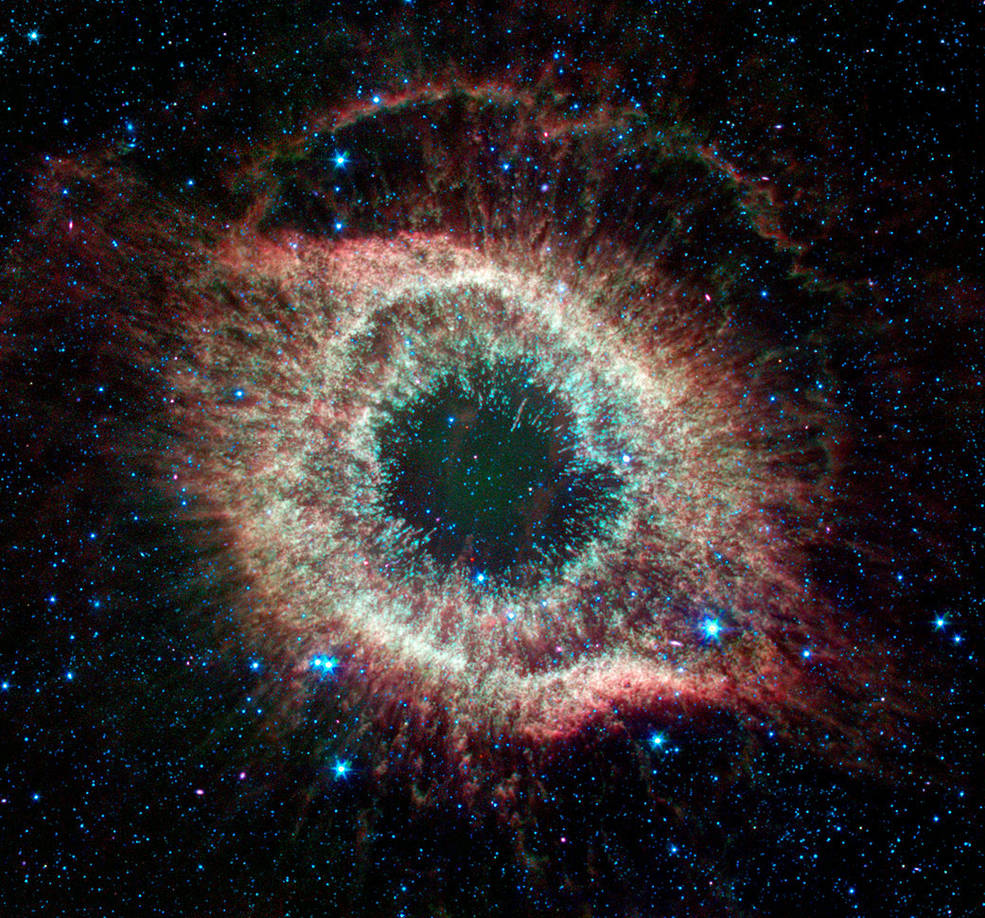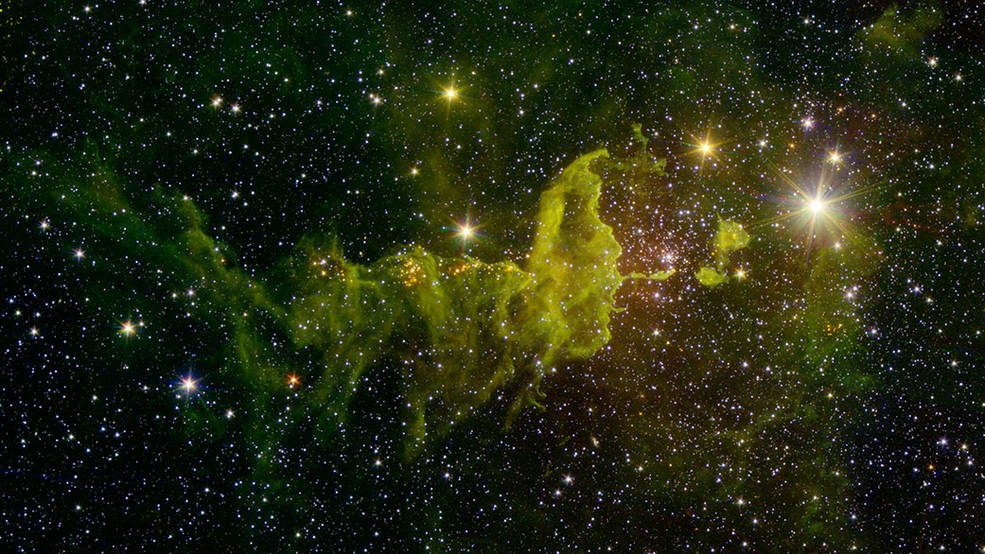NASA launched its Spitzer Space Telescope into orbit around the Sun on Aug. 25, 2003. Since then, the observatory has been lifting the veil on the wonders of the cosmos, from our own solar system to faraway galaxies, using infrared light.
Here are 10 amazing images from the mission.
1. Giant Star Makes Waves

|
| (C) Nasa |
Giant star Zeta Ophiuchi and the bow shock, or shock wave, in front of it. Visible only in infrared light, the bow shock is created by winds that flow from the star, making ripples in the surrounding dust.
Located roughly 370 light-years from Earth, Zeta Ophiuchi dwarfs our Sun: It is about 6 times hotter, 8 times wider, 20 times more massive and about 80,000 times as bright. Even at its great distance, it would be one of the brightest stars in the sky were it not largely obscured by dust clouds.
2. The Seven Sisters Pose for Spitzer

|
| (C) Nasa |
The Pleiades star cluster, also known as the Seven Sisters, is a frequent target for night sky observers.
Viewed in the infrared, the stars seem to float on a bed of feathers. The filaments surrounding the stars are dust, and the three colors represent different wavelengths of infrared light. The densest portion of the dust cloud appears in yellow and red, and the more diffuse outskirts appear in green hues.
3. Young Stars in their Dust

|
| (C) Nasa |
Newborn stars peek out from beneath their blanket of dust in this image of the Rho Ophiuchi nebula. Called “Rho Oph” by astronomers and located about 400 light-years from Earth, it’s one of the closest star-forming regions to our own solar system.
4. The Infrared Helix

|
| (C) Nasa |
Located about 700 light-years from Earth, the eye-like Helix nebula is a planetary nebula, or the remains of a Sun-like star.
When these stars run out of their internal fuel supply, their outer layers puff up to create the nebula. The nebula is heated by the hot core of the dead star, called a white dwarf, which is not visible in this image but is located in the middle of the “eye.” Our Sun will blossom into a planetary nebula when it dies in about 5 billion years.
5. The Tortured Clouds of Eta Carinae

|
| (C) Nasa |
The bright star at the center of this image is Eta Carinae, one of the most massive stars in the Milky Way galaxy. With around 100 times the mass of the Sun and at least 1 million times the brightness, Eta Carinae releases a tremendous outflow of energy that has eroded the surrounding nebula. Spitzer’s infrared vision lets us see the dust, shown in red, as well as clouds of hot, glowing gas, which appear green.
6. Spitzer Spies Spectacular Sombrero

|
| (C) Nasa |
Located 28 million light-years from Earth, Messier 104 — also called the Sombrero galaxy or M104 — is notable for its nearly edge-on orientation as seen from our planet.
Spitzer observations were the first to reveal the smooth, bright ring of dust (seen in red) circling the galaxy. Spitzer’s full view also shows the disk is warped, often the result of a gravitational encounter with another galaxy, and clumpy areas spotted in the far edges of the ring indicate young star-forming regions. Hubble Space Telescope data showing starlight appears blue.
7. Spitzer Captures Our Galaxy’s Bustling Center

|
| (C) Nasa |
This infrared mosaic offers a stunning view of the Milky Way galaxy’s busy center. The pictured region, located in the Sagittarius constellation, is 900 light-years agross and shows hundreds of thousands of mostly old stars amid clouds of glowing dust lit up by younger, more massive stars.
8. A Space Spider Watches Over Young Stars

|
| (C) Nasa |
Located about 10,000 light-years from Earth in the constellation Auriga, the Spider nebula resides in the outer part of the Milky Way. Combining data from Spitzer and the Two Micron All Sky Survey (2MASS), the image shows green clouds of dust illuminated by star formation in the region. Right of center, against the black background of space, lies a bright group of stars called Stock 8.
9. Cartwheel Galaxy Makes Waves

|
| (C) Nasa |
Approximately 100 million years ago, a smaller galaxy plunged through the heart of the Cartwheel galaxy, creating ripples of brief star formation.
The first ripple appears as a bright blue outer ring around the larger object, radiating ultraviolet light visible to GALEX. The clumps of pink along the outer blue ring are X-ray (observed by Chandra) and ultraviolet radiation.
A combination of visible and infrared light from Hubble and Spitzer, the yellow-orange inner ring and center of the galaxy represent the second ripple, or ring wave, created in the collision. Tints of green are older, less-massive visible-light stars.
10. Spitzer and Hubble Create Colorful Masterpiece

|
| (C) Nasa |
Located 1,500 light-years from Earth, the Orion nebula is the brightest spot in the sword of the constellation Orion.
Four massive stars, collectively called the Trapezium, appear as a yellow smudge near the image center. Visible and ultraviolet data from Hubble appear as swirls of green that indicate the presence of gas heated by intense ultraviolet radiation from the Trapezium’s stars.
Less-embedded stars appear as specks of green, and foreground stars as blue spots. Meanwhile, Spitzer’s infrared view exposes carbon-rich molecules called polycyclic aromatic hydrocarbons, shown here as wisps of red and orange. Orange-yellow dots are infant stars deeply embedded in cocoons of dust and gas.
